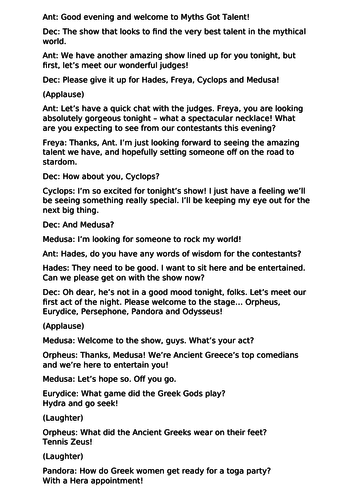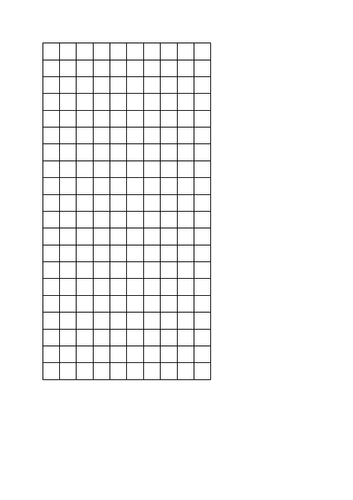33Uploads
79k+Views
56k+Downloads
All resources

Roald Dahl Themed Instructions Comprehension
Two differentiated comprehension worksheets based on Roald Dahl-themed recipes/instructions. Comprehension questions cover a range of skills including retrieval, authorial intent and word choice.

Minpins Differentiated Reading Comprehension
Reading comprehension questions based on Roald Dahl’s The Minpins - differentiated four ways!
This resource was planned and delivered for a Year 3 class, but could easily be used for KS1, UKS2 and lower ability KS3.

The Journey Home Reading Comprehension
A set of multi-skill comprehension questions based on the text The Journey Home by Frann Preston-Gannon.
This activity is part of a unit of work around The Journey Home. Please see my other resources for more!

Myths and Legends Class Assembly/Radio Script
A Britain’s Got Talent-style script featuring different characters from a range of myths and legends, including Hades, Cyclops, Perseus, Medusa and the Minotaur!
My Year 5 class performed this as a radio program after a unit on Myths and Legends in English, but it could easily be used with younger and older children as a class assembly.

Biscuit Bear Design Booklet (D&T)
A design booklet for children to explore, design, make and evaluate their own biscuits after reading the story of Biscuit Bear by Mini Grey.
This resource is part of a unit of work around Mini Grey, Biscuit Bear and The Adventures of the Dish and the Spoon.
Please see my other resources for more!

A Midsummer Night's Dream Inference and Prediction Activity
To be used prior to reading A Midsummer Night’s Dream. Originally used as a carousel activity of book covers, images and extracts for children to annotate, predicting and inferring information about the plot, characters and setting.

The Lighthouse Keeper's Lunch Planning and Resources KS1
Comprehensive planning based around The Lighthouse Keeper’s Lunch. The children make predictions about the story whilst reading, answer differentiated comprehension questions to demonstrate their understanding of the text, learn the story using T4W and then produce a story board of the main events. The final written outcome is a diary entry from the perspective of the main character, Mr Grinling, using differentiated success criteria and a pre-prepared WAGOLL. All planning, differentiated resources and IWB flipcharts included.
Learning objectives covered:
To make predictions about a text.
To sequence a story.
To show an understanding of events and characters through a diary entry.

Traditional Stories Planning and Resources - Jack and the Beanstalk
Planning and resources for three weeks of traditional stories focusing on Jack and the Beanstalk. Over the course of the unit, children will:
Explore the typical characters in a traditional story
Understand the key features of a traditional story
Sequence events
Retrieve and infer
Create a conversation between two characters
Draft and write a newspaper report based on the events in a traditional story

Superheroes Planning and Resources KS1/LKS2 (Historical Figures and Art & Design)
Includes detailed, differentiated and engaging lesson plans and resources for History and Art within the theme of superheroes.
The children begin to understand what a ‘hero’ is and make links to historical figures who can be thought of as heroes. They then go on to investigate symbols and design and make their own superhero capes and masks.
The objectives covered are:
To explore the life of Florence Nightingale.
To explore the life of Mary Seacole.
To explore the similarities and differences between Mary Seacole and Florence Nightingale.
To explore the life of Edith Cavell.
To explore the life of Nelson Mandela.
To write a biography of Nelson Mandela.
To explore the lives of historical heroes.
To research and present information.
To investigate symbols.
Please see my other uploads, including Supertato which we covered in English and links really well to this unit!

Beach/Seaside Poetry Unit of Work - Two Week Planning and Resources KS1/LKS2
Two weeks of detailed and engaging planning and resources based around beach/seaside poetry. This was planned and delivered for a Year 2 class but could easily be adapted to suit Year 1 or LKS2. IWB flipcharts, worksheets, resources and planning included!
Objectives covered:
To identify different types of poems and poetic devices.
To identify and explore poetic devices.
To demonstrate an understanding of a poem.
To perform a poem using expression, volume and intonation.
To give opinions on a shape poem.
To gather language for a shape poem.
To draft a shape poem using poetic devices.
To edit and improve a shape poem using poetic devices.
To write a shape poem using poetic devices.
This unit was planned and taught alongside a beach/seaside Topic unit - please see my other resources for more!

Local Area Unit of Work and Resources - KS1/LKS2 (Geography, History, Art and Science)
A detailed and comprehensive plan for a unit of work based around ‘Street Detectives’ and local history with IWB flipcharts and differentiated worksheets included. The planning covers a range of Geography and History objectives with a focus on the local area which can be easily adapted, and also Art and Science with a link to local buildings and habitats.
Learning objectives covered:
To understand what our local area is like and how it may have changed over time.
Ask questions about how our local area has changed over time.
Ask questions about how our local area has changed over time.
To use geographical vocabulary to name features of familiar and unfamiliar places.
Identify and describe geographical human and physical features using an aerial photograph.
To draw simple maps or plans using symbols for a key.
Describe human and physical features seen in their local environment.
Describe how people, places and events in their own locality have changed over time.
To investigate building designs.
To use digital media to create a photo collage in the style of David Hockney.
To investigate shapes, patterns and decorations on buildings.
To identify living things and their habitats within the local environment.
To describe how animals get their food from plants and other animals.
To identify living things and their habitats within the local environment.

Beach/Seaside Two Week Plan and Resources
Planning and resources for ‘Beachcombers’ topic suitable for Year 2 but could be adapted to suit LKS2. The download includes detailed and comprehensive planning, differentiated worksheets and IWB flipcharts to support teaching.
Learning objectives covered:
To demonstrate what I already know and to ask questions.
To identify and locate the seas surrounding the UK.
To compare and contrast our locality with a seaside locality (Weston-Super-Mare).
To conduct a geographical survey.
To use ICT to present findings.
To identify and locate where else in the world we can have a seaside holiday.
Following on from the Humanities objectives, I went on to cover an animals and habitats unit in Science and seaside Art based on Alfred Wallis ; please feel free to contact me if you would like the resources and planning for these.

Volume Investigation
A practical volume investigation for KS2/KS3 pupils
This lesson was used for an observation after the children had spent a week learning about volume. The children construct boxes and investigate volume by cutting different sized squares from the corner of a grid to find out which dimensions give the greatest volume. Lots of opportunity for discussion and reasoning. I delivered this lesson the day before Eid so linked it to party boxes, but it could be easily adapted!
Differentiated 5 ways and includes IWB flipchart, activity sheets and worksheets.













